CENTRAL PROBLEMS OF AN ECONOMY
Economic System
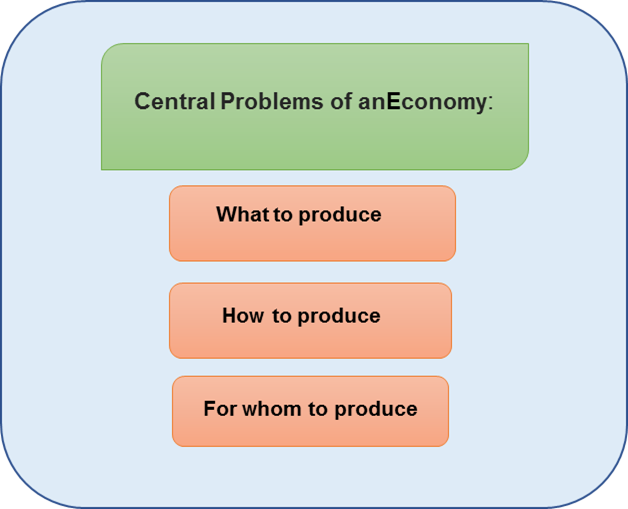
- What to Produce - It involves deciding the final combination of goods and services to be produced i.e. it involves a selection of goods and services and the quantity of each, that the economy should produce.
- How to Produce - It involves deciding the technique of production i.e. whether selected goods are to be produced with more labor and less capital or with more capital and less labor.
- For whom to Produce - It involves deciding the distribution of output among people i.e. it involves the selection of the category of people who will ultimately consume the goods.
TYPES OF ECONOMIC SYSTEMS
TYPES OF ECONOMIC SYSTEMS
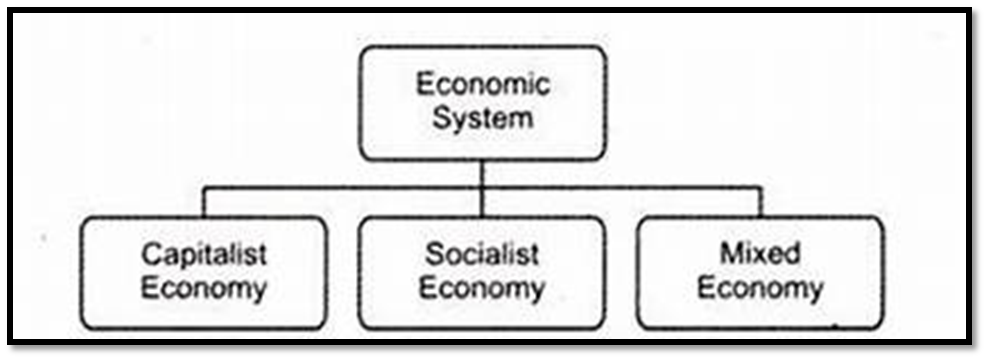
CAPITALIST ECONOMY
Definition: An economy where the means of production are owned by individuals who can freely take their decisions with the motive of profit-maximization is called a capitalist economy.
Features of the Capitalist Economy are:
- Private ownership of means of production
- Profit maximization is the primary motive and government is confined to ensuring law and order.
Merits:
- Promotes self-interest, profit maximization and acceleration of GDP growth.
Demerits:
- The collective interest of society is ignored.
- Production of only high-profit goods.
- Growth without social justice.
SOCIALIST ECONOMY
Definition: The economy in which there is the social ownership of means of production and the important decisions are taken by some central authority of the government with a view to maximizing social welfare is called a socialist economy.
Features of a Socialist Economy are:
- Collective ownership of means of production.
- Maximized social welfare due to direct participation of the state.
Merits:
- Tries to achieve equality in the distribution of income, along with inclusive growth and social justice.
Demerits:
- Slow GDP growth
- Profit maximization is replaced by the principle of ‘ Equity and Justice’
MIXED ECONOMY
Definition: An economy, which has both private and public ownership of means of production, is called a Mixed economy.
Features of a Mixed economy are:
- Private and government (public) ownership.
- Profit- maximization is the governing principle in decisions for Private ownership and Social welfare in Government or Public ownership.
Merits:
- Combines the best features of both capitalist and socialist economies like GDP growth ensured by Private entrepreneurs and social justice by the government.
Demerits:
- The government sector is often inflicted with corruption therefore a low level of efficiency.
India adopted a mixed economy.
Some leaders were in favor of a Socialist Economy however in a democratic country like India, complete dilution of private ownership was not possible. The capital economic system did not appeal to our first prime minister, as there would be fewer chances of improvement in the quality of life of people. As a result, the Mixed economy was adopted. (with best features of both socialist and capitalist economy).
ECONOMIC PLANNING
Economic Planning
Definition: Economic planning can be defined as making major economic decisions (what, how and for whom) by the conscious decision of a determinate authority, on the basis of a comprehensive survey of the economy as a whole.
- A system where a central authority, in this case, the Planning Commission, now NITI Aayog, in India sets a set of targets and mentions programs to be achieved within a specific period of time.
- For the development of the Indian economy, it was necessary for the government to plan for the economy, known as Economic planning.
- The purpose of the commission is to carefully assess the human and physical resources of the country and to prepare the plans for the effective use of resources.
- The planning commission fixed the planning period at 5 years, which began the era of ‘five-year plans’.
Need for Planning:
Owing to the backwardness and stagnation in the economy, it could not be left in the hands of market forces of supply and demand to make way for growth and development. A heavy investment supported by the government was required and therefore Planning in India was needed.
Directive & Comprehensive Planning:
- Directive Planning: System of planning where planning is used to direct the forces of supply and demand. There is no direct participation of the state in the process of growth; it is solely there for ensuring law and order. This principle is mostly pursued in capitalist economies.
- Comprehensive Planning: System in which government participates in the process of growth and development. This planning is mostly pursued in mixed and socialist economies.
LONG PERIOD AND SHORT PERIOD GOALS
- Long Period Goals- Common to all Five-year plans and studied as Objectives of Planning.
- Short Period Goals- Plan-Specific and studied as Objectives of Plans.
Long period and short period objectives should not contradict each other and be coordinated.
Long Period Goals/Objectives
- GDP Growth- An increase in GDP means an increase in the level of output, which further means an increase in the flow of goods and services. A consistent increase in the flow of goods and services in an economy for a long period is called Economic growth; therefore, an increase in GDP is equal to an increase in economic growth. This increase depends upon increasing the resource base of the country and an increase in productivity through innovative technology.
- Full Employment- it is a situation where people who are willing to work and able to work at the given market wage rate. This leads to ‘inclusive growth’, achieving the motive of growth and social justice together
- Equitable Distribution or Equity- Economic growth becomes meaningless if only a few people receive its benefits; therefore, it should reach all sections of the society in order to become equitable.
- Modernization - Means updating and adopting modern technology. For example the Green Revolution, and IT Revolution. Modernization in terms of social outlook as well for example women empowerment.
- Self-Sufficiency- This means dependence on domestically produced goods, primarily food grains so the country is not exposed to any political pressure from the rest of the world.
Short Period Goals/Objectives
- This depends on the current needs of the economy.
- Initially started with First plan focusing on higher agricultural production,
- The second plan focused on the industry, Third self-sufficiency and fuller utilization of labor and so on.
- They have to complement the long period goals and objectives, be coordinated with them and not contradict them.
GOALS OF FIVE-YEAR PLANS
The five-year plans have been concerned with the removal of the economic backwardness of the country and making India a developed economy. The five-year plans have also been taken care of to ensure that the weaker sections of the population benefit from the economic progress of the country.
- The first five-year plan was launched for a period starting from 1" April 1951 and ending on 31 March 1956.
- Each five-year plan listed the basic Goals of India's development, which served as the guiding principles of Indian planning.
These basic goals are:
- Growth
- Modernization
- Self-reliance
- Equity
Growth
- Growth refers to an increase in the country's capacity to produce the output of goods and services within the country.
- Growth implies:
- Either a larger stock of productive capital.
- A larger size of supporting services like transport and banking
- An increase in the efficiency of productive capital and services.
- A good indicator of economic growth, in the language of economics, is a steady increase in the Gross Domestic Product (GDP).
- GDP refers to the market value of all the final goods and services produced in the country during a period of one year. An increase in GDP or availability of goods and services enables people to enjoy a more rich and varied life.
- In some countries, growth in agriculture contributes more to GDP growth, while in some countries; growth in the service sector contributes more to GDP growth.
- The contribution of each sector makes up the structural composition of the economy.
Modernization
Modernization includes:
- Adoption of New Technology: Modernisation aims to increase the production of goods and services through the use of new technology. For example, a farmer can increase the output on the farm by using new seed varieties instead of using the old ones. Similarly, a factory can increase output by using a new type of machine.
- Change in social outlook: Modernisation also requires a change in social outlooks, such as gender empowerment or providing equal rights to women. A society is prosperous if it makes use of the talents of women in the workplace.
Self-reliance
- Self-reliance under Indian conditions means overcoming the need for external assistance. In other words, it means to have developed through domestic resources.
- To promote economic mote economic growth and modernization, the five-year plans stressed the users own resources, in order to reduce our dependence on foreign countries.
- The policy of self-reliance was considered a necessity because of two reasons.
- To reduce foreign dependence: As India was recently freed from foreign control, it is necessary to reduce our dependence on foreign countries, especially for food. Therefore, stress should be given to attain self-reliance.
- To avoid Foreign Interference: It was feared that dependence on imported food supplies, foreign technology and foreign capital might increase foreign interference in the policies of our country.
Equity
- It is important to ensure that benefits of economic prosperity are availed by all sections (rich as well as poor) of the economy.
- In addition to the objectives of growth, modernization and self-reliance, equity is also important
- According to Equity, every Indian should be able to meet his or her basic needs (food, house education and health care) and inequality in the distribution of wealth should be reduced.
- In short, Equity aims to raise the standard of living of all people and promote social justice.
AGRICULTURAL SECTOR
AGRICULTURE
- At the time of independence, the land tenure system was characterized by intermediaries (like zamindars) who merely collected rent (Lagaan) from the actual tillers of the soil.
- The low productivity of the agricultural sector forced India to import food from the United States of America.
- The agricultural sector accounted for the largest share of the workforce with approximately 70 75 percent. So, agricultural development was focused right from the First Five Year Plan.
Features (or Problems) of Agriculture
- Low Productivity: Indian agricultural sector was known for its low productivity. Lack of knowledge was responsible for stagnation in this sector.
- Disguised Unemployment: It refers to a state in which more people are engaged in work than are really needed. There were very high incidents of disguised unemployment in the sector between 1950 and 1990.
- 3. High dependency on Rainfall: Due to poor agricultural techniques, farmers depended largely on rainfall. There was minimum growth in this sector in the year that receives the least rainfall.
- Subsistence Farming: It is the practice of growing crops only for one's own use without any surplus for trade. There were also very high incidents of subsistence farming.
- Outdated Technology: There were many obsolete technologies and harvesting machines. Harvesting was generally done manually and was very tedious.
- Conflicts between Tenants and Landlords: Farmers were often a part of a critical contract that bound them to their landlords. Landlords used to extract a huge amount of interest from farmers and deprived them of their necessities.
Policies for Growth of Agriculture
The measures undertaken to promote the growth in the agricultural sector can be broadly categorized as 'Land Reforms' and 'Green Revolution
- Land Reforms
Definition: Land Reforms primarily refer to changes in the ownership of landholdings, Land reform measures have been introduced by various underdeveloped and developing countries, for attaining a rational land distribution pattern and viable farming structure.
- There was a great need for land reforms in a country like India, where the majority of its population still depends on agriculture.
- Land reforms were needed to achieve the objective of Equity in agriculture.
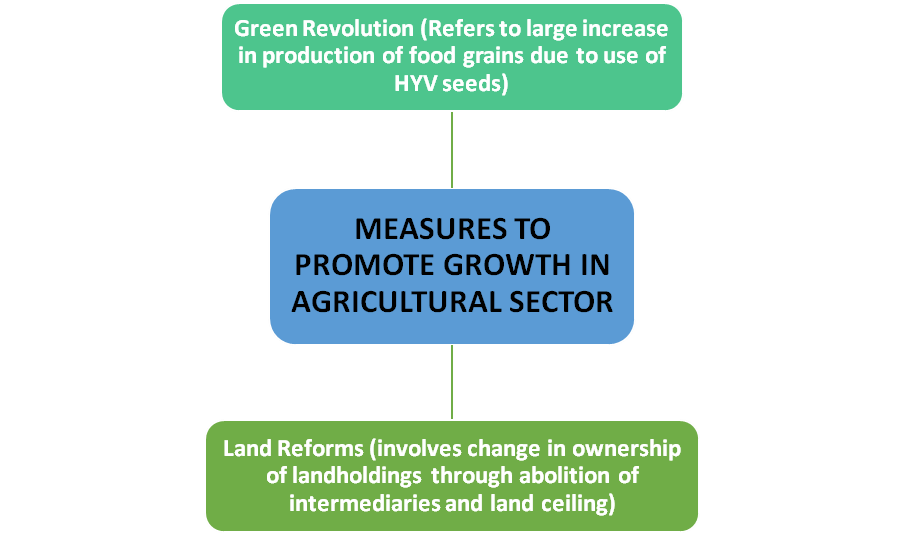
Abolition of Intermediaries
- The idea behind this step was that ownership of land would give incentives to the actual tillers to make improvements (provided sufficient capital was made available to them).
- The abolition of intermediaries brought 200 lakh tenants into direct contact with the government.
- The ownership rights granted to tenants gave them the incentive to increase output and this contributed to growth in agriculture.
However, the goal of equity was not fully served by abolition of intermediaries because of following reasons:
- In some areas, the former zamindars continued to own large areas of land by making use of some loopholes in the legislation.
- In some cases, tenants were evicted and zamindars claimed to be self-cultivators:
- Even after getting the ownership of land, the poorest of the agricultural laborers did not benefit from land reforms.
Land Ceiling
Definition: Land Ceiling refers to fixing the specified limit of land, which could be owned by an individual.
- Beyond the specified limit, all lands belonging to a particular person would be taken over by the Government and will be allotted to the landless cultivators and small farmers.
- The purpose of land ceiling was to reduce the concentration of land ownership in a few hands
- Land ceiling helped to promote equity in the agricultural sector.
- However, the land ceiling legislation was challenged by the big landlords. They delayed its implementation. This delay time was used by them to get the land registered in the name of close relatives, thereby escaping from the legislation.
Conclusion
Land reforms were successful in Kerala and West Bengal because the governments of these states were committed to the policy of land reforms. Unfortunately, other states did not have the same level of commitment and vast inequality in landholdings continued.
- New Agricultural Strategy: Green Revolution
- The new agricultural strategy was adopted in India during the Third Plan, i.e., during 1960s. The traditional agricultural practices followed in India were gradually being replaced by modern technology and agricultural practices. The aim of this strategy was to raise agricultural production and productivity in selected regions of the country through the introduction of modern inputs like fertilizers, credit, marketing facilities, etc.
Green Revolution
- India's agriculture vitally depends on the monsoon and in case of a shortage of monsoon, the farmers had to face a lot of Green Revolution troubles.
- Moreover, the productivity in the agricultural sector was very low due to the use of outdated technology and absence of required infrastructure.
- As a result of intensive and continued efforts of many agricultural scientists, this stagnation in agriculture was permanently broken by the 'Green Revolution'
Green Revolution refers to the large increase in production of food grains due to the use of high-yielding variety (HYV) seeds. Green Revolution is a spectacular advancement in the field of agriculture.
- HYV Seeds: Main Reason for Agricultural Revolution
- These seeds can be used in those places where there are adequate facilities for drainage and water supply.
- As compared to other ordinary seeds, these seeds need heavy doses of chemical fertilizers (4 to 10 times more fertilizers) to get the largest possible production.
- So, to derive benefit from HYV seeds, Indian farmers need seeds, the yield multiplied to have:
-
- Reliable irrigation facilities
- Financial resources (to purchase fertilizers and pesticides).
Important Effects of Green Revolution
The spread of Green Revolution technology-enabled India to achieve self-sufficiency in food grains. India was no longer at the mercy of America, or any other nation, regarding the food requirements.
- Attaining Marketable Surplus: Green Revolution resulted in 'Marketable Surplus’. Marketable surplus refers to that part of agricultural produce that is sold in the market to farmers after meeting their own consumption requirement
- Growth in agricultural output makes a difference to the economy only when proportion of this increase is sold in the market.
- Fortunately, a good proportion of rice and wheat produced during the green revolution period was sold by the farmers in the market.
- Buffer Stock of Food Grains: The green revolution enabled the government to procure a sufficient amount of food grains to build a stock, which could be used in times of shortage.
- Benefit to low-income groups: As a large proportion of food grains was sold by the farm in the market, their prices declined relative to other items of consumption. The low-income groups, who spend a large percentage of their income on food, benefited from this decline in relative prices.
Risks involved Under Green Revolution
- Risk of Pest Attack: The HYV crops were more prone to attack by pests. Therefore, there was a risk that small farmers who adopted this technology could lose everything in a pest attack. However, this risk was considerably reduced by the services rendered by research institutes established by the government.
- Risk of Increase in Income Inequalities: There was a risk HYV Crops were prone to that costly inputs (HYV seeds, fertilizers, etc.) required attack by Posts under green revolution will increase the disparities between small and big farmers since only the big farmers could afford the required inputs.
Favorable steps taken by the government led to the eradication of these fears:
- True access to the needed inputs. The government provided loans at a low-interest rate to small farmers so that they could also have access to the needed inputs.
- Since the small farmers could obtain the required inputs, the output on small farms equaled the output on large farms in the course of time. As a result, the green revolution benefited small as well as rich farmers.
Subsidies to Agriculture
Definition: Subsidy, in the context of agriculture, means that the farmers get inputs at prices lower than the market prices.
Economists in Favour of Subsidies
- The government should continue with agricultural subsidies as farming in India continues to be a risky business.
- Majority of the farmers are very poor and they will not be able to afford the required inputs without the subsidies.
- Eliminating subsidies will increase the income inequality between rich and poor farmers and will violate the ultimate goal of equity.
Economists against the Subsidies
- According to some economists, subsidies were granted by the Government to provide an incentive for adoption of the new HYV technology. Therefore, after the wide acceptance of technology, subsidies should be phased out as their purpose has been served.
- Subsidies do not benefit the poor and small farmers (target group) as benefits of a substantial amount of subsidy go to the fertilizer industry and prosperous farmers.
Critical Appraisal of Agricultural Development (1950-1990)
- The Land Reform measures and Green Revolution' were the greatest achievements of the Indian Government, in enhancing agricultural production and productivity.
- Between 1950 and 1990, there had been a substantial increase in agricultural productivity. As a result of Green revolution, India became self-sufficient in food production. Land Reforms resulted in abolition of zamindari system.
- The Proportion of GDP between 1950 and 1990 contributed by agriculture declined significantly, but not the population depending on it.
- Around 65% of the country's population continued to be employed in agriculture, even till 1990. Agricultural output could have been grown with much less people working in the sector, but industrial and service sectors were unable to absorb the extra people involved in agriculture.
INDUSTRIAL DEVELOPMENT
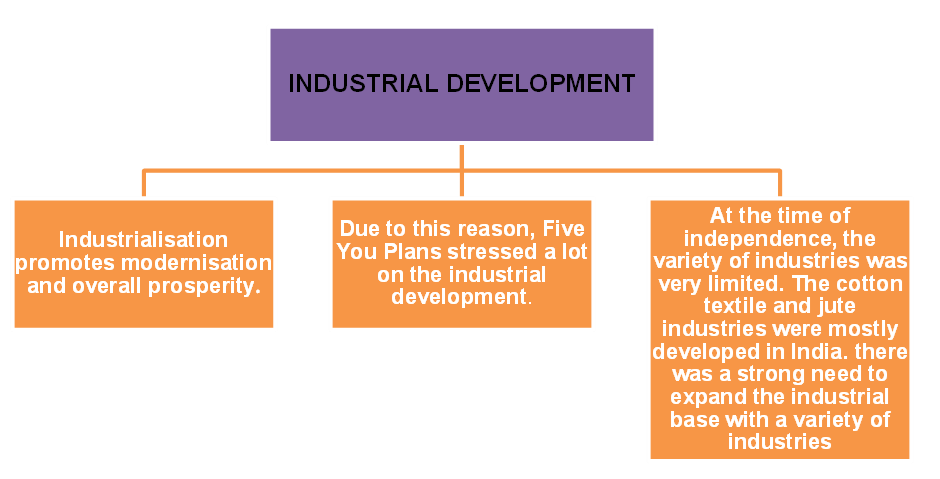
Role of Public Sector in Industrial Development
There was a need for a leading role in the Public Sector due to the following reasons:
- Shortage of Capital in Private Sector: Private entrepreneurs did not have the capital to undertake investment in industrial ventures, required for the development of the Indian economy. At the time of independence, Tatas and Birlas were the only well-known Private entrepreneurs. As a result, the Government had to make an industrial investment through Public Sector Undertakings (PSUs).
- Lack of Incentive for the Private Sector: The Indian market was not big enough to encourage private industrialists to undertake major projects, even if they had the capital to do so. Due to the limited size of the market, there was a low level of demand for industrial goods.
- Objective of Social Welfare: The objective of equity and social welfare of the Government could be achieved only through direct participation of the state in the process of industrialization As a result; the state had complete control over those industries that were vital for the economy.
Industrial Policy Resolution 1956
Industrial Policy is a comprehensive package of policy measures, which covers various issues, and connects with different industrial enterprises of the country.
- Industrial Policy is essential for devising various procedures, principles, rules and regulations for controlling the industrial enterprise of the country.
- After the Industrial Policy, of 1948, the Indian economy had to face a series of economic and political changes, which necessitated the need for a fresh industrial policy for the country. So, on 30 April 1956, a second Industrial Policy Resolution was adopted in India.
Classification of Industries
According to Industrial Policy Resolution 1956, the industries were reclassified into three categories, viz., Schedule A, Schedule B and Schedule C:
- Schedule A: This first category comprised industries that would be exclusively owned by the state. In this schedule, 17 industries were included, like arms and ammunitions; atomic energy; heavy and core industries; aircraft, oil; railways, shipping, etc.
- Schedule B: In this schedule, 12 industries were placed, which would be progressively state-owned. The state would take the initiative of setting up industries and the private sector will supplement the efforts of the state. This schedule includes industries like aluminum, other mining industries, machine tools, fertilizers, etc.
- Schedule C: This schedule consisted of the remaining industries which were to be in the private sector. The state would facilitate and encourage the development of all these industries These industries were controlled by the state through a system of licenses, enforced under the Industries (Development and Regulation) Act, 1951.
Industrial Licensing
Definition: An industrial license is written permission from the government, to an industrial unit to manufacture goods. The government can issue licenses for:
- Setting up of new industries;
- Expansion of existing ones; and
- Diversification of products.
- According to Industrial Licensing, No new industry was allowed unless a license is obtained from the government.
- It was easier to obtain a license if the industrial unit was established in an economically backward area. In addition, such units were given certain concessions, such as tax benefits and electricity at a lower tariff. The purpose of this policy was to promote regional quality.
- License was needed even if an existing industry wants to expand output or diversify production. License to expand production was given only if the government was convinced that there is a need for a larger quantity of goods in the economy.
Small-Scale Industry (SSI)
Definition: A small-scale industry is defined with reference to the maximum investment allowed on the assets of a unit. This limit has changed from rupees five lakh in 1950 to the present limit of rupees one crore.
- Employment Generation: Small-scale industries are more labor-intensive, i.e., they use more labor than large-scale industries and, therefore, generate more employment. After agriculture, small-scale industries provide employment to the largest number of people in India.
- Need for Protection from Big Firms: Small-scale industries cannot compete with big industrial firms. They can flourish only when they are protected from large firms. Therefore, the government for their growth took various steps.
- Reservation of Products: Government reserved production of a number of products for the small-scale industry. The criterion for reserving the products depended on the ability of these units to manufacture the goods.
- Various Concessions: Small-scale industries were also given concessions, such as lower excise duty and bank loans at lower interest rates.
CRITICAL APPRAISAL OF INDUSTRIAL DEVELOPMENT
- The proportion of GDP contributed by the industrial sector increased in the period from 11.8% in 1950-51 to 24.6% in 1990-91. This rise in the industry's share of GDP is an important indicator of development. The 6% annual growth rate of the industrial sector during the period is also admirable.
- Indian industry was no longer restricted to cotton textiles and jute. It also included engineering goods and a wide range of consumer goods. The industrial sector became well-diversified by 1990, largely due to the public sector.
- The promotion of small-scale industries gave opportunities to people with small capital to get into business. New investment opportunities helped in generating more employment It promoted growth with equity.
- Protection from foreign competition (through Import Substitution) enabled the development of indigenous industries in the areas of electronics and automobile sectors, which otherwise could not have developed. However, this protection had two drawbacks:
- Inward Looking Trade Strategy: Our policies were 'inward oriented' and so we failed to develop a strong export sector.
- Lack of Competition: Due to restrictions on imports, some domestic producers made sincere efforts to improve the quality of their goods and it forced the Indian consumer to purchase, whatever they produce. The domestic industry failed to achieve international standards of product quality.
- Licensing Policy helped the government to monitor and control the industrial production However, excessive regulation by the government created two difficulties:
- Misuse: It was misused by industrial houses. Some big industrialists would get a license, not for starting a new firm, but to prevent competitors from starting new firms.
- Time-Consuming: The cumbersome and complex procedure for obtaining a license was very time-consuming. Industrialists in trying to obtain a license spent a lot of time.
- Public sector made a remarkable contribution by creating a strong industrial base, developing infrastructure and promoting development of backward areas.
- However, the public sector continued to monopolize (that too ineffectively) in certain non-essential areas, which could be well handled by the private sector. For Examples, telecommunication, hotel industry, production of goods (like Modern Bread).
- As a result, precious funds of public sector were channelized into areas, where private sector could have been easily engaged.
- Many public sector firms also incurred huge losses but continued to function because of difficulty in closing a government undertaking.
- Many scholars criticized the monopoly of public sector in such non-essential areas. According to them, the role of public sector should be limited to strategic other non-essential areas. Areas (like national defense) and private sector should be given the opportunity for other non-essential areas.
FOREIGN TRADE
FOREIGN TRADE
Foreign trade in India includes all imports and exports to and from India. In 1950, India's share in the total world trade was 1.78%
Trade Policy: Import Substitution
- In order to be self-reliant in vital sectors, India has followed the strategy of replacing many imports by domestic production. .
- In the first seven plans, trade was characterised by an inward-looking Trade Strategy This strategy is called 'Import Substitution'.
- Import Substitution refers to a policy of replacement or substitution of imports by domestic production. . For example, instead of importing vehicles made in a foreign country, domestic industries would be encouraged to produce them in India itself.
- The basic aim of the policy was to protect domestic industries from foreign competition.
- The policy of Import Substitution can serve 2 definite objectives: (1) Savings of precious foreign exchanges and (ii) Achieving self-reliance.
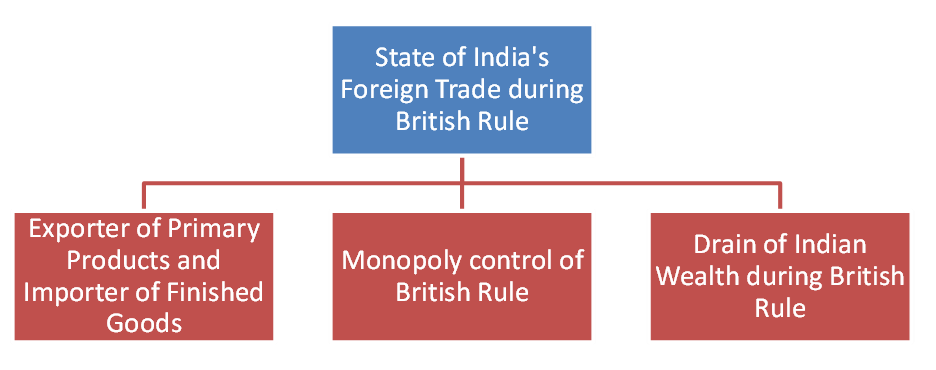
Protection from Imports through Tariffs' and 'Quotas
1. Tariffs: Tariffs refer to taxes levied on imported goods. The basic aim of imposing a heavy duty on imported goods was to make them more expensive and discourage their use.
2. Quotas: Quotas refer to fixing the maximum limit on the imports of a commodity by a domestic producer. The tariff on imported goods and fixation of quotas helped in restricting the level of imports. As a result, the domestic firms could expand without fear of competition from the foreign market.
Reason for Import Substitution
1. The policy of protection (in the form of Import Substitution) is based on the notion that industries of developing countries, like India, are not in a position to compete against the goods produced by more developed economies. With protection, they will be able to compete in the due course of time.
2. Restriction on imports was necessary, as there was a risk of the drain of foreign exchange reserves on the import of luxury goods.
CONCLUSION
Conclusion
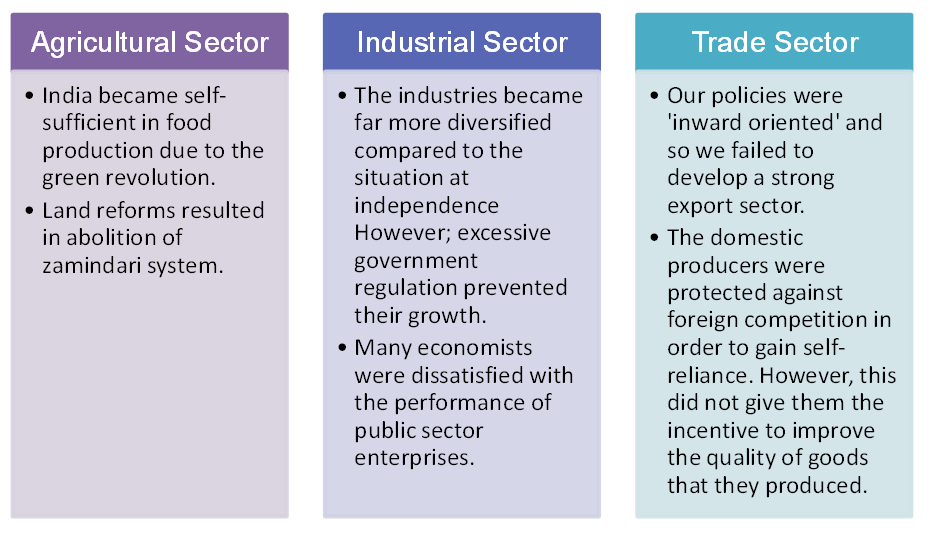
The need for reform of economic policy was widely felt in the context of changing global economic scenario. So, the New Economic Policy (NEP) was initiated in 1991, to make the economy more efficient.

 PathSet Publications
PathSet Publications
